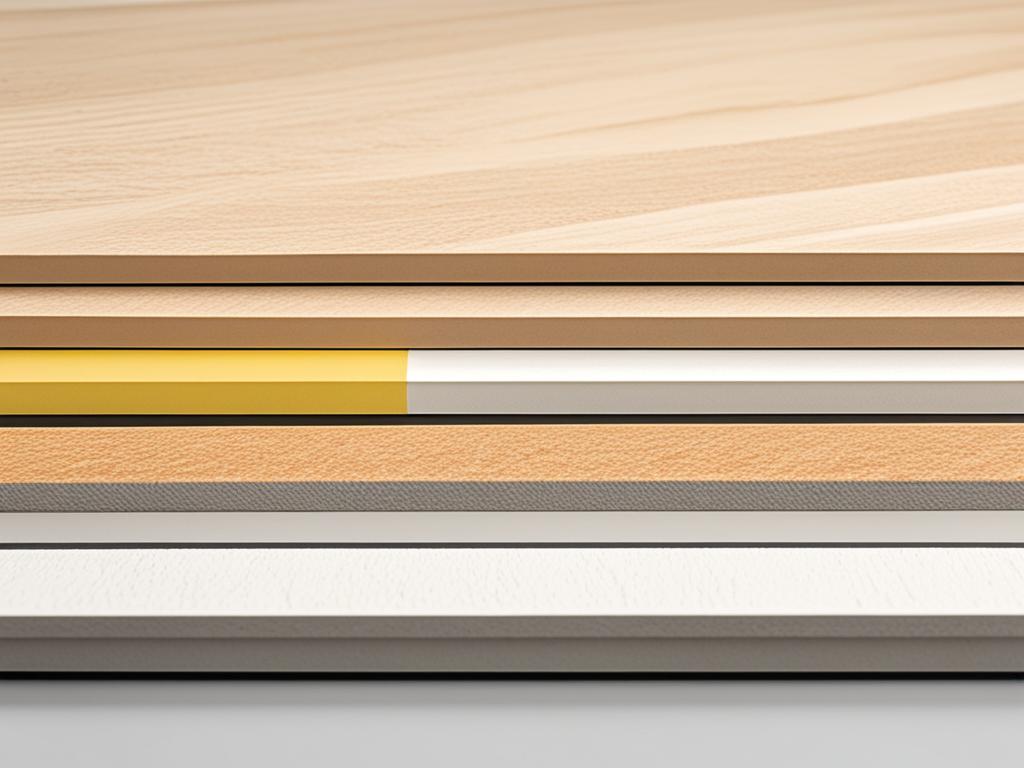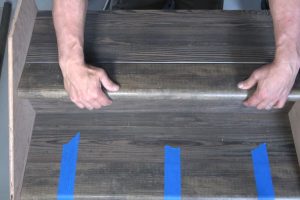When it comes to tile edging, there are two popular options to choose from: bullnose and pencil trim. Both options serve to provide a finishing touch to a tile installation and create a polished appearance. Understanding the differences between these two types of trim can help you make an informed decision for your project.
Key Takeaways:
- Bullnose trim involves using smaller, rounded tiles to smoothen out the edges of a tile design.
- Pencil trim refers to thin, cylindrical pieces that are placed along the edges of mosaic tiles.
- Bullnose trim typically has a more rounded and curved edge, while pencil trim has a straighter and thinner profile.
- The choice between bullnose and pencil trim ultimately depends on the desired aesthetic and style of the project.
- Consider the overall style and design of your space when selecting the right trim for your project.
What is Bullnose Trim?
Bullnose trim is a popular choice for adding a finishing touch to tile installations. This type of trim involves using smaller, rounded tiles to smoothen out the edges of a tile design. It is often used to go around corners and niches, creating a clean and seamless transition from the tile to the wall or other surfaces.
Bullnose trim comes in various materials, styles, and colors, allowing for design flexibility. Whether you’re looking for a sleek and modern look or a more traditional aesthetic, there is a bullnose trim option to suit your needs. This versatile trim adds an elegant touch to any tile project, enhancing its overall appearance and providing a polished finish.
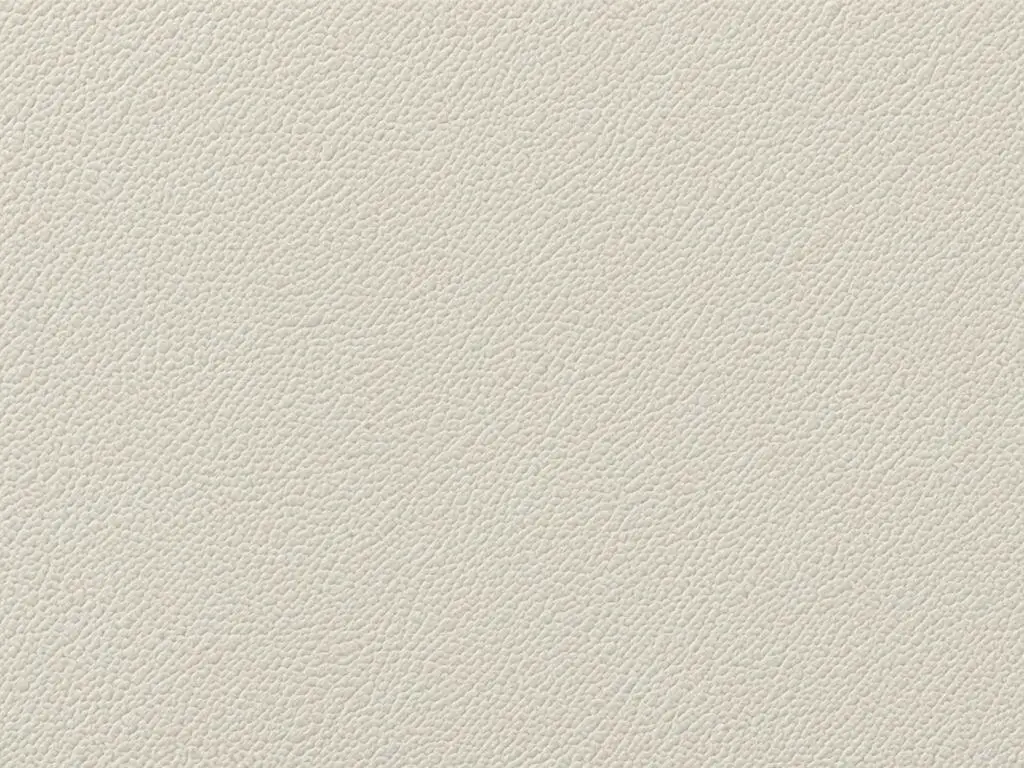
What is Pencil Trim?
Pencil trim is a sleek and stylish option for adding a finishing touch to your tile project. Made from thin cylindrical pieces, pencil trim is specifically designed to be placed along the edges of mosaic tiles, acting as a raised frame that adds a subtle border to the overall design. Its slim profile creates clean edges without overwhelming the tile pattern, making it a popular choice for various applications such as backsplashes, shower surrounds, and accent borders.
With its elegant and understated appearance, pencil trim brings a touch of sophistication to any space. Its versatility allows it to seamlessly blend with different tile styles and materials, enhancing the overall aesthetic of the installation. Whether you’re going for a contemporary, modern look or a timeless, classic design, pencil trim can elevate the visual impact of your tile project.
Like other types of tile trim, pencil trim not only enhances the visual appeal but also serves a practical purpose. It helps protect the edges of the mosaic tiles, preventing them from chipping or becoming damaged over time. This ensures the longevity and durability of your tile installation.
Key Features of Pencil Trim:
- Sleek and thin cylindrical profile
- Seamlessly frames the edges of mosaic tiles
- Adds a subtle border to the tile design
- Enhances the overall aesthetic of the installation
- Protects tile edges from chipping or damage
When selecting pencil trim for your project, consider the material, color, and finish that best complements your tile choice. Whether you opt for a glossy or matte finish, a metallic or natural material, pencil trim offers a versatile range of options to suit your personal style.
Now that you’re familiar with pencil trim, let’s explore the key differences between bullnose and pencil trim in the next section to help you make an informed decision for your tile project.
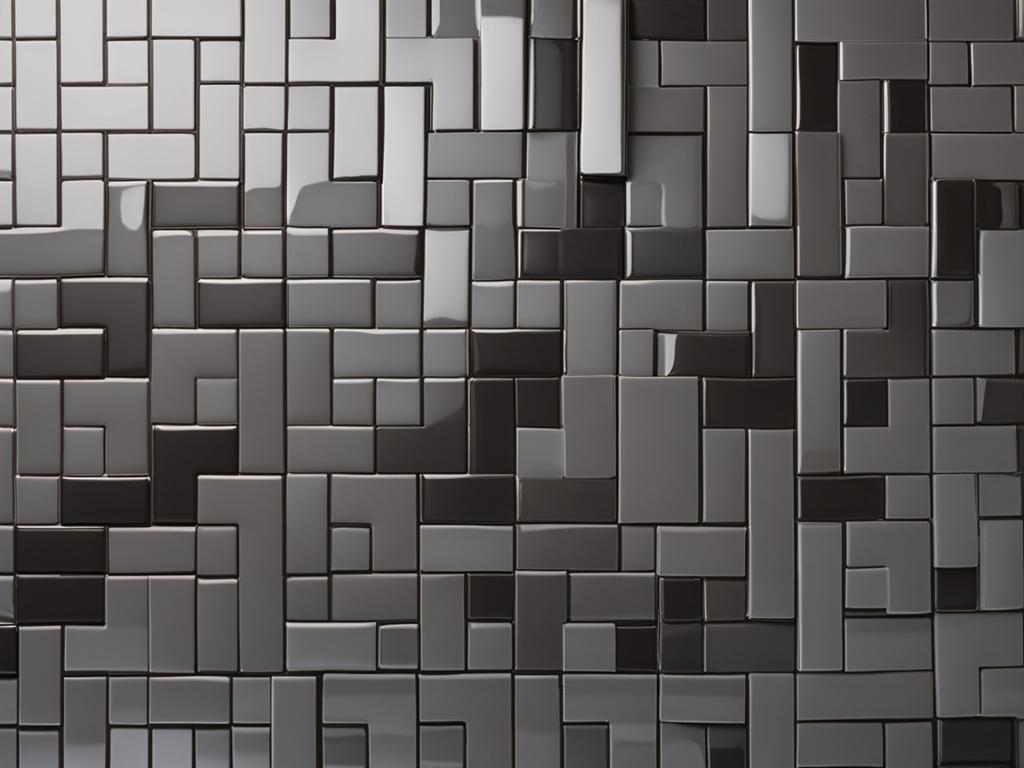
Key Differences Between Bullnose and Pencil Trim
When it comes to tile edging, two popular options to consider are bullnose trim and pencil trim. While both serve a similar purpose of providing a polished finish to a tile installation, there are some key differences between the two.
Bullnose Trim: Bullnose trim is known for its rounded and curved edge. This type of trim is commonly used to create a smooth transition, especially around corners and niches. It offers a softer and more traditional look that complements various tile designs and styles.
Pencil Trim: On the other hand, pencil trim has a straighter and thinner profile. It offers a clean and minimalistic border that adds a touch of sophistication to mosaic tile designs. Pencil trim is often chosen for its sleek and contemporary appeal.
Depending on the desired aesthetic and style of your project, you can choose between bullnose and pencil trim. Bullnose trim is ideal for achieving a smooth and seamless transition, while pencil trim offers a modern and refined look. Consider your overall design vision and preferences to select the trim that best enhances your tile installation.
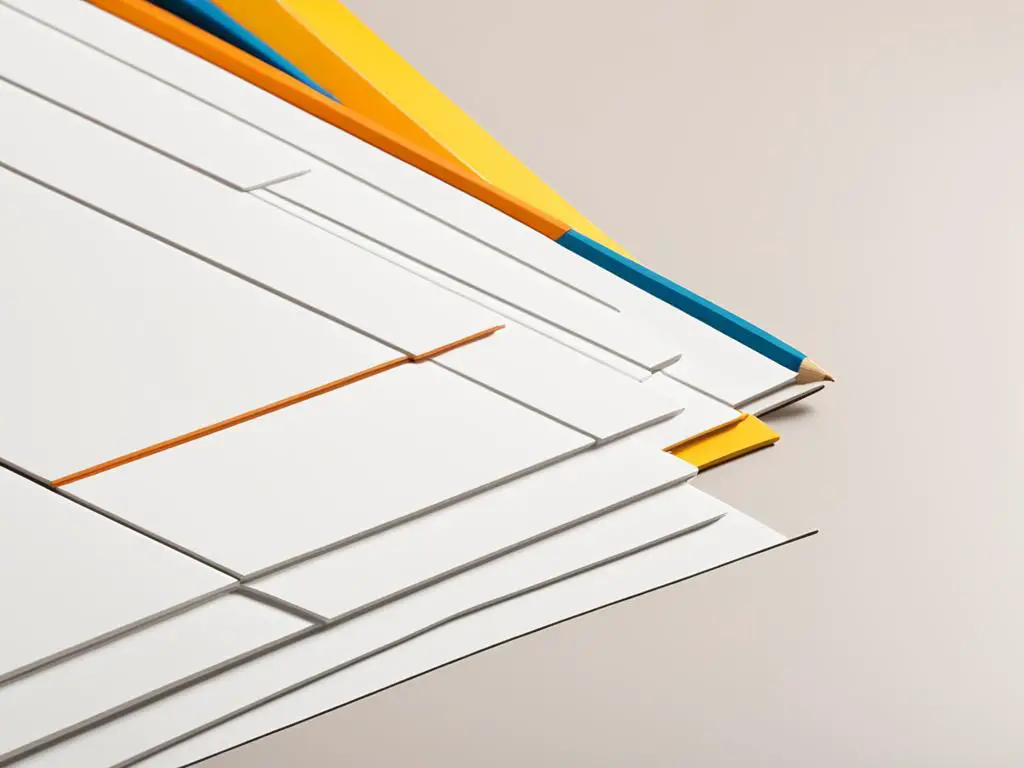
“Bullnose trim is a popular choice for creating a smooth transition, especially around corners and niches.”
Comparison Table: Bullnose vs Pencil Trim
| Bullnose Trim | Pencil Trim |
|---|---|
| Rounded and curved edge | Straighter and thinner profile |
| Creates a smooth transition | Adds a clean and minimalistic border |
| Traditional look | Modern and refined appeal |
Choosing the Right Trim for Your Project
When it comes to tile edging, selecting the right trim is crucial to achieving a polished and finished look for your project. Consider the following factors to make an informed decision that complements your style and design:
- Overall Style and Design: Take into account the overall aesthetic of your space. If you’re aiming for a traditional look, bullnose trim may be the ideal choice. On the other hand, if you prefer a contemporary or minimalist feel, pencil trim might be more suitable.
- Material and Color: Ensure that the trim material and color harmonize with your tile selection. Whether you opt for ceramic, porcelain, or natural stone, the trim should enhance the visual appeal of your tiles.
- Functionality: Determine the purpose of the trim. Are you looking to create a smooth transition between different surfaces, protect tile edges, or add a decorative touch? Understanding the functional requirements will guide you in selecting the appropriate trim.
Consulting with a design professional or visiting a tile showroom can provide valuable insights and recommendations tailored to your specific project. By considering the overall style, material, color, and functionality, you can choose the right trim that perfectly complements your tile installation.
Expert Tip: Don’t underestimate the power of professional advice. Design professionals have the expertise and experience to help you find the perfect trim that aligns with your vision and requirements.
Pros and Cons of Bullnose and Pencil Trim
| Trim Type | Pros | Cons |
|---|---|---|
| Bullnose Trim |
|
|
| Pencil Trim |
|
|
Understanding the advantages and disadvantages of both bullnose and pencil trim can help you make an informed decision based on your project’s requirements and desired aesthetic.
Other Tile Edging Options
While bullnose and pencil trim are popular choices for tile edging, there are other options available to add the perfect finishing touch to your tile installation. These alternative tile trims provide a range of styles, colors, and materials to suit your design preferences. Let’s explore some of the other tile edging options:
1. Edge Glazing
Create a vibrant and eye-catching look with edge glazing. This option adds a pop of color to the edges of the tiles, allowing you to customize the appearance of your tile installation. Whether you want to match your tiles or make a bold contrast, edge glazing offers endless possibilities.
2. Chair Rail Trim
For a more ornate and decorative look, consider chair rail trim. This type of trim adds an elegant touch to your tile design, helping to create a unique and stunning focal point in your space. Chair rail trim is available in various styles and materials, allowing you to find the perfect match for your aesthetic.
3. Schluter®-SCHIENE Finishing
Add a touch of metallic sheen to your tile edges with Schluter®-SCHIENE finishing. This option provides a sleek and modern look, perfect for contemporary or industrial-style spaces. Available in different materials such as aluminum, stainless steel, and brass, Schluter®-SCHIENE finishing offers both durability and style.
4. Cove Base Trim
Create a seamless transition between your wall and floor with cove base trim. This option is designed to fit snugly along the bottom edge of your tiles, providing a clean and finished appearance. Cove base trim is available in various colors and materials, enabling you to coordinate with your tile selection.
5. Baseboard Trim
Add an elegant and stylish touch to your tile installation with baseboard trim. This option frames the edges of your tiles, creating a polished and sophisticated look. Baseboard trim is available in different styles and materials, allowing you to achieve the perfect balance between functionality and aesthetics.
Exploring these alternative tile edging options can help you find the perfect solution to elevate the appearance of your tile installation. Whether you’re aiming for a vibrant and colorful design or a sleek and modern look, these options offer versatility and style.
The Importance of Tile Finishing
Tile finishing plays a crucial role in both the practical and aesthetic aspects of your tile installation. By incorporating tile trim, you can enjoy numerous benefits that enhance the overall appearance and longevity of your tiles.
One of the primary advantages of tile trim is its ability to protect the edges of your tiles from chipping or damage. Whether you have a high-traffic area or a tile that is exposed to moisture, using trim ensures the edges remain intact, maintaining the structural integrity of the installation.
Moreover, tile trim creates a polished and finished look, elevating the visual appeal of your tiles. It adds a professional touch by providing clean and defined edges, giving your project a sense of sophistication and completion.
Additionally, tile trim facilitates a smooth transition between the tiles and other surfaces such as walls or countertops. This seamless integration enhances the overall aesthetic harmony of the space, making it visually pleasing and cohesive.
A well-executed tile finishing not only protects your tiles but also adds a touch of elegance to your space, creating a lasting impression.
By carefully selecting the right trim and paying attention to the finishing details, you can achieve a flawless and cohesive look for your tile project. Whether you prioritize functionality or aesthetics, tile finishing is an essential element that shouldn’t be overlooked.
| Benefits of tile finishing: |
|---|
| Protection for tile edges |
| Enhanced visual appeal |
| Smooth transition with other surfaces |
Conclusion
In conclusion, when deciding between bullnose and pencil trim for your tile project, it’s important to consider your desired style, functionality, and overall design aesthetic. Both options have their unique benefits and can greatly enhance the look of your tiles.
Remember to also explore alternative tile edging options to find the perfect fit for your specific project. Whether you ultimately choose bullnose, pencil trim, or another type of tile trim, the key is to achieve a polished and finished result that complements your overall design vision.
By carefully considering the different trim options available and taking into account factors such as the material, color, and application, you can create a tile installation that’s not only protected and durable but also visually stunning. Taking the time to select the right trim will ensure that your tile project is a success and that you’re left with a beautifully finished space.
FAQ
What is bullnose trim?
Bullnose trim involves using smaller, rounded tiles to smoothen out the edges of a tile design. It provides a clean and seamless transition from the tile to the wall or other surfaces.
What is pencil trim?
Pencil trim refers to thin, cylindrical pieces that are placed along the edges of mosaic tiles. It acts as a raised frame for the tiles and adds a subtle border to the design.
What are the key differences between bullnose and pencil trim?
Bullnose trim has a more rounded and curved edge, while pencil trim has a straighter and thinner profile. Bullnose is ideal for smooth transitions around corners, while pencil trim is popular for creating minimalistic borders.
How do I choose the right trim for my project?
Consider the overall style and design of your space. If you prefer a traditional look, bullnose trim may be better. If you want a contemporary feel, pencil trim might be ideal. Also, think about the material and color of the trim.
What are some other tile edging options?
Other options include edge glazing, chair rail, Schluter®-SCHIENE finishing, cove base, and baseboard trim.
Why is tile finishing important?
Tile trim protects the edges of the tiles, enhances the appearance of the installation, and provides a smooth transition between the tile and other surfaces.
